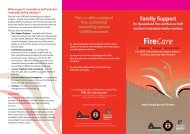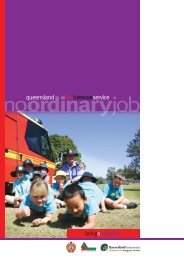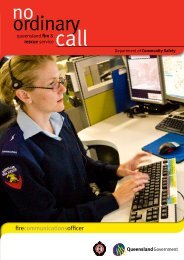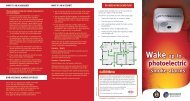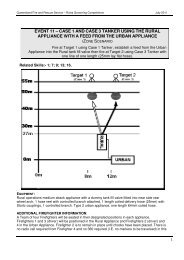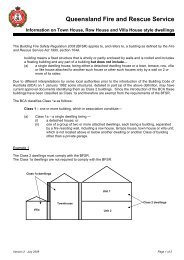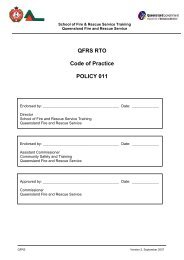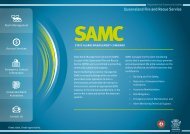Photoelectric Smoke Alarms - Queensland Fire and Rescue Service ...
Photoelectric Smoke Alarms - Queensland Fire and Rescue Service ...
Photoelectric Smoke Alarms - Queensland Fire and Rescue Service ...
Create successful ePaper yourself
Turn your PDF publications into a flip-book with our unique Google optimized e-Paper software.
For people with philosophical concerns about the radiation in ionisation alarms,<br />
the alternative is photoelectric smoke alarms which are highly recommended by all<br />
Australian fire services because of their better smoke detection qualities. These<br />
are particularly good at detecting fires that start without immediate flames <strong>and</strong><br />
only small amounts of smoke.<br />
<strong>Photoelectric</strong> smoke alarms, which do not contain any radioactive material, are<br />
also safe for disposal through normal household rubbish disposal methods.<br />
Other smoke alarm facts<br />
<br />
<br />
<br />
<br />
<br />
<br />
<br />
<br />
Research indicates that a primary reason why smoke alarms do not operate<br />
when needed is because batteries have been removed, often after repeated<br />
false alarms. Only working smoke alarms save lives.<br />
False alarms are often caused by steam from bathrooms or by cooking fumes.<br />
<strong>Smoke</strong> alarms should be positioned carefully to avoid false alarms caused by<br />
steam or cooking fumes.<br />
Research indicates that photoelectric smoke alarms are less prone to false<br />
alarms from cooking fumes.<br />
<strong>Smoke</strong> alarms not be installed in close proximity to kitchens <strong>and</strong> bathrooms as<br />
steam <strong>and</strong> cooking can cause unwanted alarms.<br />
Due consideration be given to the effect on smoke alarm performance by air<br />
conditioners, heaters, fans <strong>and</strong> other temperature control devices. <strong>Smoke</strong><br />
alarms should be located where these devices will not compromise the<br />
effectiveness of the smoke alarms.<br />
<strong>Smoke</strong> alarms can be installed as either st<strong>and</strong> alone independent alarms or<br />
they can be interconnected. Interconnection allows all smoke alarms to sound<br />
simultaneously when any one alarm activates. This alerts all occupants <strong>and</strong><br />
maximises the opportunity for escape.<br />
Children’s bedrooms should have a smoke alarm <strong>and</strong> be connected to the<br />
parent’s bedroom because children sleep more soundly than adults.<br />
A significant percentage of residences fitted with smoke alarms remain<br />
unprotected due to depleted or missing batteries.<br />
What is the difference between<br />
smoke alarms <strong>and</strong> smoke<br />
detectors?<br />
<strong>Smoke</strong> alarms are self-contained, single or multiple-station smoke-sensing<br />
devices. <strong>Smoke</strong> alarms may include two or more single station units wired to<br />
operate in conjunction with each other. <strong>Alarms</strong> have a detection device <strong>and</strong><br />
sounder. <strong>Smoke</strong> alarms are required in most domestic settings.<br />
<strong>Smoke</strong> detectors are smoke-sensing devices that are not self-contained <strong>and</strong> are<br />
intended for use in conjunction with a fire alarm system control panel. Detectors<br />
only have a detection device. <strong>Smoke</strong> detectors are often found in high rise<br />
apartment buildings <strong>and</strong> are frequently used in conjunction with smoke alarms.<br />
The <strong>Queensl<strong>and</strong></strong> <strong>Fire</strong> <strong>and</strong> <strong>Rescue</strong> <strong>Service</strong> offers a FREE fire <strong>and</strong> home safety visit to<br />
resident <strong>Queensl<strong>and</strong></strong>ers whether they rent or own a home.<br />
As part of the service, fire fighters will provide advice on the correct positioning <strong>and</strong><br />
installation of smoke alarms as well as their maintenance <strong>and</strong> replacement.<br />
If a <strong>Queensl<strong>and</strong></strong>er lives in a part of <strong>Queensl<strong>and</strong></strong> serviced by volunteer rural fire fighters,<br />
a fire fighter may not be able to visit the home. If this is the case, the caller will receive<br />
a Safehome kit, a Bushfire Preparedness package, <strong>and</strong> contact details for their local<br />
fire station.<br />
To request a Safehome booking with a <strong>Queensl<strong>and</strong></strong> fire fighter from your local station,<br />
telephone 1300 369 003 or request your booking on-line at www.fire.qld.gov.au. Type<br />
Safehome into the search engine, <strong>and</strong> complete <strong>and</strong> submit the form on-line.<br />
FREE assistance with smoke alarms <strong>and</strong> other fire <strong>and</strong> safety issues in the home<br />
18<br />
19




